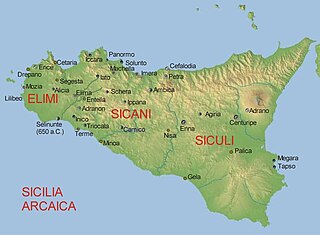Sicani
| Sicanian | |
|---|---|
| Sicana | |
| Region | Sicily |
| Extinct | approximately 300 BCE[citation needed] |
| Language codes | |
Phoenicians and the Greeks). | |
 Tribes of Hellenic Sicily | |
The Sicani or Sicanians were one of three
History
The Sicani are the oldest inhabitants of Sicily with a recorded name. In the 5th century BCE, the Greek historian
It is generally agreed by scholars that the Sicani preceded other inhabitants of Sicily in prehistory, namely the Elymians and Sicels. The former are thought to be the next recorded people to settle Sicily. According to Hellanicus of Lesbos, Elymians were a population of Italic origin, who arrived in Sicily after having fought a war with the Oenotrians.[15] They settled in the north-west corner of the island, forcing the Sicanians to move across eastward. The Sicels were the next to arrive, from mainland Italy, and settled in the east. The arrival of the Sicels is thought to have occurred during the thirteenth or eleventh century BCE. The Sicanians area after this became limited to the south-western part of the island with settlements in the area of Gela and Agrigentum.[16]
The Sicani enter the historical record with the Phoenicians, who established colonies during the 11th century BCE – preceding the Greeks, who founded the colony of
Herodotus and King Minos
Minos, according to tradition, went to Sicania, or Sicily, as it is now called, in search of Daedalus, and there perished by a violent death.[17]
Language
A few short inscriptions using the
See also
- Ancient peoples of Italy
- Prehistoric Italy
References
- ^ Diod., v.6.3-4
- ^ Thucydides, His. VI,2,3,4.
- ^ "Sicily: Encyclopedia II – Sicily – History". Experience Festival. 7 October 2007. Archived from the original on 31 December 2013.
- ^ "Aapologetico de la literatura española contra los opiniones". Ensayo historico. 7 October 2007.
- ISBN 9004133003.
- ^ As reported in Diodorus Siculus V,6,1-3.
- ISBN 0-674-03314-0.
- ^ "Pausanias, Description of Greece, Elis 1, chapter 25, section 6". www.perseus.tufts.edu. Retrieved 2021-12-26.
- Naturalis Historia, III, 56; III, 69.
- ^ Arias, Paolo Enrico (1943). Problemi sui Siculi e sugli Etruschi (in Italian). Crisafulli.
- ^ Virgil, Aeneid, VII, 795; VIII, 328; XI, 317;
- ^ Aulus Gellius, Attic Nights, I, 10.
- ^ Macrobius, Saturnalia, I, 5.
- ^ Fine, p.72
- ^ "Gli Elimi: storia e archeologia di Segesta, Erice, Entella". www.arkeomania.com. Retrieved 2021-12-26.
- OCLC 760889060.[page needed]
- ^ Herodotus, The History, George Rawlinson, trans., (New York: Dutton & Co., 1862
- ^ The World's Writing Systems. 1996:301.
- ^ "'Sicanian' at Linguist List". Archived from the original on 2012-03-01. Retrieved 2008-07-28.
- ^ ISBN 9781139851930.
External links
- The death of Minos in Sicily
- Sicilian Peoples: The Sicanians by Vincenzo Salerno
